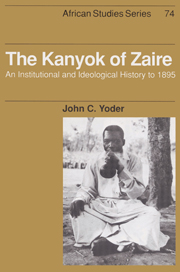Book contents
- Frontmatter
- Contents
- List of maps and figures
- Acknowledgments
- Abbreviations
- Chronology
- Introduction
- 1 Wood and wine, gardens and game
- 2 Stratification, symbols, and spirits
- 3 New legends for new leaders
- 4 Serpents and lightning
- 5 Dances, moats, and myths
- 6 Combat, classes, titles, and trade
- 7 Schisms and slaves, ghosts and guns
- 8 Assassinations, alliances, and ambushes
- APPENDIX: Methodology
- Notes
- Bibliography
- Index
- Titles in the series
7 - Schisms and slaves, ghosts and guns
The Kanyok face new challenges, ca. 1825 to 1880
Published online by Cambridge University Press: 29 September 2009
- Frontmatter
- Contents
- List of maps and figures
- Acknowledgments
- Abbreviations
- Chronology
- Introduction
- 1 Wood and wine, gardens and game
- 2 Stratification, symbols, and spirits
- 3 New legends for new leaders
- 4 Serpents and lightning
- 5 Dances, moats, and myths
- 6 Combat, classes, titles, and trade
- 7 Schisms and slaves, ghosts and guns
- 8 Assassinations, alliances, and ambushes
- APPENDIX: Methodology
- Notes
- Bibliography
- Index
- Titles in the series
Summary
The middle decades of the nineteenth century were politically challenging as civil strife, schism, and foreign invasions plagued the Kanyok people and the state. In part, these upheavals were the result of the new economic and political opportunities in the decades following the conclusion of Kanyok–Luba hostilities. The political stability which came at the end of the wars, the opening of trade with the Luso-African commercial system, and the growing Kanyok sphere of influence in the region all increased the stakes of politics at Mulundu. Initially, by drawing on loyal clients and terrifying supernatural powers, Mwen a Kanyok Ciam a Ciband (ruled ca. 1830–ca. 1850) was able to stabilize and strengthen the Mulundu regime. After 1850, however, when the impact of Western capitalism on the savannas and forests of Central Africa became more direct and more intense, competition for the office of Mwen a Kanyok grew increasingly bitter and divisive. Not only was the chief's chair at Mulundu constantly threatened by coups, but the Kanyok state eventually was divided into two antagonistic halves, as guns, not law and tradition, became the most important tools and symbols of political control. By 1875 the land was in such turmoil that a Luba slave trader Kasonga Cinyama was able to oust the sitting Mwen a Kanyok and seize the chief's chair for himself. Although his rule was brief, after his departure Cokwe slave raiders and Luso-African merchants introduced even greater chaos into the Luilu valley.
- Type
- Chapter
- Information
- The Kanyok of ZaireAn Institutional and Ideological History to 1895, pp. 111 - 128Publisher: Cambridge University PressPrint publication year: 1992



